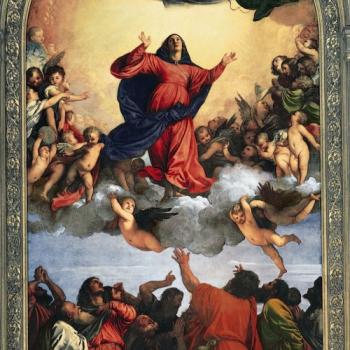One of the ways to judge the state of a given culture is to look at its arts. That which a society uses to indicate beauty tells us much about its understanding of goodness and of truth. For the aesthetic desires of a culture tells us what that culture is attracted to, what it finds to be good, and what it seeks out to be true. Obviously, within any culture, there will be a variety of artistic approaches; we must look for general trends, not the exceptions, to understand the aesthetic reality of a given society.[1] Western art, as a whole, has undergone serious degeneration throughout the last century. G.K. Chesterton once predicted that the future of Western art would be tied to its capitalistic exploitation. “There will be no art that might not just as well be advertisement. I do not necessarily mean that there will be no good art; much of it might be, much of it already is, very good art. You may put it, if you please, in the form that there has been a vast improvement in advertisements. […] But the improvement of advertisements is the degradation of artists. It is their degradation for this clear and vital reason: that the artist will work, not only to please the rich, but only to increase their riches; which is a considerable step lower. […] And no one who knows the small-minded cynicism of our plutocracy, its secrecy, its gambling spirit, its contempt of conscience, can doubt that the artist-advertiser will often be assisting enterprises over which he will have no moral control, and of which he could feel no moral approval.”[2] To Chesterton, the artist would still be able to perfect their technical skills, but those skills would only be used for capitalistic enterprises, and art would become a tool by which society was manipulated. While Chesterton was right in suggesting capitalism would end up sapping the strength out of the arts (and the artist), his prediction, as it turns out, was way too optimistic. Western art degenerated, not only because it became a tool of the capitalistic enterprise, but also because it would, in the end, represent the society that capitalism produces: a junk society. Modern art is trash because it shows us the inner core and teleological end of our modern way of life.
This is not to say there are no good artists, and that all of modern art is initially trash. But even brilliant artists such as M.C. Escher are, in their own way, drawn into the system which has worked to destroy the arts. Consumerism wants to be productive, to create something new which attracts attention; novelties like the works of Escher represent the best of this aspect of the process of consumerism: someone actually did something which attracts attention; people want in on it. People buy replicas of Escher’s art, demonstrating their connection to his work. But after awhile, the novelty wears out. Something new takes its place – out with the old, and in with the new. What is to happen with the old? It is slowly turned into junk. Eventually it is junk. The artist which is in tune to this process understands what will be made of their work, and decides, why fight it, and so makes his art out junk itself. If it is later junked, who cares, because, after all, it was junk when it started, it was junk when it was art, and it is once again junk when it is put back into the trash heap. “Another way to make the same point would be to emphasize how, in today’s art, the gap that separates the sacred space of sublime beauty from the excremental space of trash (leftover) is gradually narrowing, up to the paradoxical identity of opposites: are not modern art objects more and more excremental objects, trash (often in a quite literal sense: faeces, rotting corpses . . .) displayed in — made to occupy, to fill in — the sacred place of the Thing? And is not this identity in a way the hidden ‘truth’ of the entire movement? Is not every element that claims the right to occupy the sacred place of the Thing by definition an excremental object, a piece of trash that can never be ‘up to its task’?“[3]
Andy Warhol, surprisingly enough a faithful Byzantine Catholic who went to daily mass,[4] is representative of one side of the modern artistic enterprise. He pointed out where art was going with its capitalistic association; he took it to its limit, and showed the meaningless value of such art. “Warhol is thus truly null, in the sense that he reintroduces nothingness into the heart of the image. He turns nullity and insignificance into an event that he changes into a fatal strategy of the image.“[5] His mass production of images of capitalistic goods was a demonstration of the insignificance of the image in modern society, showing how modern art is in itself, the new iconoclasm. “Modern iconoclasm no longer consists in destroying images, but in manufacturing a profusion of images where there is nothing to see.”[6]By making the image a meaningless spectacle, modern art works to deconstruct all art, even those forms which tried to establish meaning, by reducing them to one image out of the infinite variety which could exist. Once the image has been devalued, one image is no better than another and all beauty ends up being trash.
The nihilism of capitalism is readily apparent. It has no desire for values, for meaning, outside of the production of more capital. Culture itself becomes just another product to be used before it is trashed. But if this is the case, then, as Žižek points out, to continue to exist, to thrive, a culture needs to shock the system, more and more, as a means of drawing attention to itself, thereby guaranteeing its continuation by investors. “With the shift towards the tertiary economy (services, cultural goods), culture is less and less a specific sphere exempted from the market, and more and more not just one of the spheres of the market, but its central component (from the software amusement industry to other media productions). What this short circuit between the market and culture entails is the waning of the old modernist avant-garde logic of provocation, of the shocking of the establishment. Today, more and more, the cultural-economic apparatus itself, in order to reproduce itself in competitive market conditions, has not only to tolerate but directly to provoke stronger and stronger shocking effects and products.”[7] And if culture requires this, then the arts, which represent the ideals of the culture, must provoke; how creative the artist is in engaging such provocation will determine their status in society. Are they useful extensions of the system, are they creative advances to the system, or are they dead weight which needs to be forgotten? The artist which wants to thrive in today’s world must take the cues of society and strive to represent the future of society; they are encouraged to be malcontents deconstructing the way things are, to create a new, meaningless future which can be deconstructed by the next generation of artists. Only in this fashion can they represent society. Thus the aesthetics of a consumeristic society will be that which promotes provocative trash, because consumerism is predicated on the notion that the goods produced today are the trash of tomorrow. But more and more these goods are not objects as much as ways to experience those objects, such as cable television or the internet, so that the goods of capitalism are themselves becoming more like empty promises than anything of actual value. “What we are witnessing today, the defining feature of ‘postmodern’ capitalism, is the direct commodification of our experience: what we are buying on the market less and less are products (material objects) that we want to own, and more and more life-experiences – experiences of sex, eating, communication, cultural consumption, participation in a lifestyle. Material objects serve merely as props for such experiences, increasingly offered for free in order to seduce us into buying the true ‘experiential commodity.'”[8] And in this way, one can predict that virtual experience of the arts will become the means by which the arts are sold; art will still be trash, but it will be virtual trash, like deleted files on a computer. The objective standing of the arts in the world will one day be lost, since there will be no reason for the arts to have any. We can simulate objectivity without establishing it.
The Christian cannot accept the aesthetics of modern society. By his or her incarnational view, the Christian looks for the production of images with meaning, images of eternal significance. That which is established in the past does not need to be entirely deconstructed, does not need to rejected, does not need to be trashed. Rather, its experience needs to be affirmed and held in esteem. Instead of looking for some new object to replace the old, Christianity looks for a way to heal the imperfect object through grace, affirming its self-worth (while, of course, purifying it from flaws). Our understanding of art differs from modern society, because we don’t seek to deconstruct the image and leave it dead, but we seek to bring life to it. “A work of art is a living entity and requires special conditions in which to live and particularly in which to flourish.”[9] The Christian seeks to keep life going, to preserve it, instead of to discard it, whether or not it is human life, or its artistic representation. Consumerism, because it discards the present, can never be accepted by the Christian, because its ultimate provocation will be the destruction of the human, of human life, for its future replacement. It can never understand the value of that which is incapable of being sold, nor that which is already sold; it can only promote that which has yet to be consumed, seeking its consummation – while Christianity looks not for the destruction of old things, but their revitalization. All things become new, ever new, in Christ; and the image, representing eternity, must represent that newness in its constant affirmation as a thing of value in and of itself. Modern art is unrealistic because it rejects the value of the image, it does not see how the image can present to us a meaningful reality beyond a short-lived novelty which becomes banality. Christian art, on the other hand, must be realistic in the full sense. It must bring us in touch with truth, it must show that such truth exists, and it is not able to be consumed by capitalistic interests. It can be enriched without being tossed aside. “There are realities in the world; one comes to know them by coming into living contact with them and through them work in the worldwide sphere. This cognition may be expressed by means of art; works of art can unite us with realities that are inaccesible to our senses — such are the formal prerequisites of any artistic realism, and a tendency that rejects even one of them thereby forfeits its right to be called realism.”[10] The reason why modern art is unrealistic is because its spiritual end is to show there is no absolute truth, no absolute reality, to hold on to. Christian art, on the other hand, represents the truth of God, and must, for that respect, ever reject the advances of capitalistic relativism. For it must point out, no matter how much we partake of the truth, it is never consumed. In this way Christians must be eucharistic in their aesthetics, where the truth is partaken but never consumed. Consumeristic art tells us the mores of consumerism, and shows to us why the Christian must have nothing to do with it: it tells us that the truth is trash; this, of course, is the teaching of anti-Christ.
Footnotes
[1] In this way, the decadence of Western art as a whole should not be used to indicate there is no art of worth being produced in the West today. Obviously there is – though to what extent, and to what purpose, is a different question.
[2] G.K. Chesterton, The Utopia of the Usurers in Collected Works Volume V (San Francisco: Ignatius Press, 1987), 407.
[3] Slavoj Žižek, The Fragile Absolute (London: Verso, 2001), 25-6.
[4] Though Byzantine, his daily communication would be in a Latin rite parish.
[5] Jean Baudrillard, The Conspirary of Art. trans. Ames Hodges (Los Angeles, CA: Semiotext(e), 2005), 28
[6] ibid., 118.
[7] Slavoj Žižek, The Fragile Absolute, 25.
[8] Slavoj Žižek, “The Three Faces of Bill Gates,” pgs. 227-236 in The Universal Exception (London: Continuum, 2007): 229.
[9] Pavel Florensky, “The Church as A Synthesis of the Arts,” pgs. 101-111 in Beyond Vision: Essays on the Perception of Art. trans. Wendy Salmond (London: Reaktion Books, 2002):102.
[10] Pavel Florensky, “On Realism,” pgs. 179 – 182 in Beyond Vision: Essays on the Perception of Art. trans. Wendy Salmond (London: Reaktion Books, 2002): 181.












